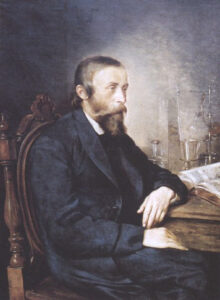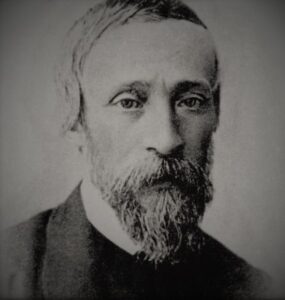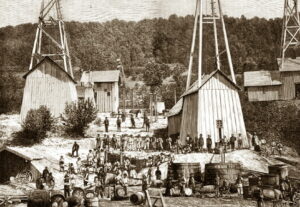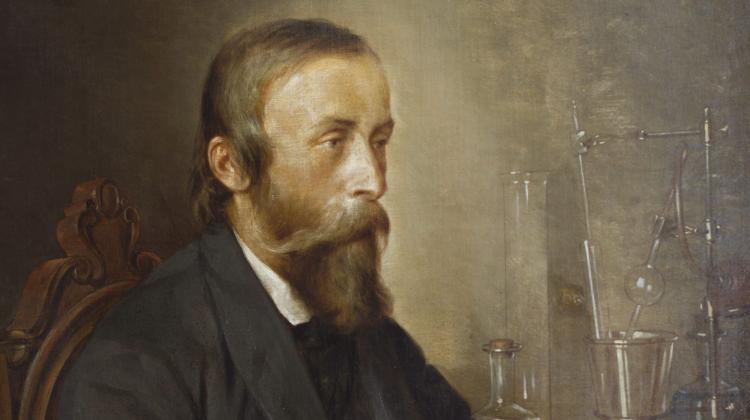In 1853, Ignacy Łukasiewicz was the first to distill kerosene from crude oil and use it to illuminate a pharmacy and then an operating theater in a hospital in Lwów. A year later, Łukasiewicz established an oil company and began extracting it from Bóbrka near Krosno, from what is now the oldest industrial crude oil mine. “Łukasiewicz Standard Oil Co.”? What a pity that this did not happen.
by Piotr Bejrowski
Ignacy Łukasiewicz was the son of a Kościuszko insurgent, and was born in 1822 in the small village of Zaduszniki in the Subcarpathian region. In 1836, due to his family’s difficult financial situation, he had to stop his studies at the Piarists’ gymnasium in Rzeszów and start working as a pharmacist’s assistant. In 1845, he joined as a special envoy to the illegal Polish Democratic Society, operating in exile, the largest Polish political party. However, the uprising in the Subcarpathian region did not take place, and Łukasiewicz was arrested and spent almost two years in prison.

After his release, he started working in the pharmacy “Pod Gwiazdą” owned by Piotr Mikolasch in Lwów. In 1850-1852, he studied pharmacy at universities in Krakow and Vienna. In 1852, he obtained a master’s degree in pharmacy in the capital of Austria, after which he returned to work in a pharmacy in Lwów, where he worked as a makeshift and conducted research on the distillation of crude oil together with Jan Zeh. After cleaning the raw material, they were the first to obtain kerosene in a laboratory, for which they quickly found a practical application. The kerosene lamp designed by Łukasiewicz soon illuminated the pharmacy window. On 31 July 1853, the same lighting was used a few weeks later during a surgery in the hospital in Łyczaków in Lwów.
The following year, Łukasiewicz moved closer to the oil area, leased a pharmacy in Gorlice, and did not stop working on the process of obtaining kerosene. Natural oil spills (then called rock oil) had been in the vicinity of Krosno “since forever”, but industrial exploitation was initiated by a company founded on the initiative of Tytus Trzecieski, who invited Łukasiewicz to Bóbrka. It is believed that Łukasiewicz answered Trzecieski: “You bring millions with you. This liquid is the country’s future wealth. It is a new industry that will bear a lot of fruit.” Trzecieski invested in the enterprise, while Łukasiewicz was the director of the world’s first oil mine for many years.
A 120 m long and 120 cm deep trench was dug at the site of the raw material leaks. After carrying out specialized excavations, significant amounts of “black gold” were quickly discovered. In 1856, entrepreneurs established an oil distillery in Ulaszowice near Jasło. The mine in Bóbrka employed workers from local villages, was famous for its good organization of work and modern, for the mid-19th century at least, methods of extraction.

Łukasiewicz continued his work on improving oil processing and obtaining the best types of kerosene. He was awarded at exhibitions in Vienna and Lwów. He personally dealt with the advertising and distribution of refining products in stores in Krakow, Tarnów and Warsaw. He made a considerable fortune in the oil industry. At the same time, in cooperation with the authorities in the field of geology and drilling, Łukasiewicz was constantly working on improving drilling techniques in Bóbrka: he introduced a manual drilling rig, and then decided to use steam engines to drive drill rigs, thanks to which the mine was drilled to a depth of 240 meters.
Łukasiewicz was also a philanthropist and social activist, and in the last years of his life a member of the Galician National Sejm. He also financially supported independence movements and co-financed and solicited the construction of schools, churches and road infrastructure. Thanks to his activity, the Krosno region was said to have the best roads and bridges in the entire province. He also contributed to the development of geological maps of the region and obtaining state subsidies for further drilling in Galicia.
He established a lace-making school for girls in the vicinity of the nearby mine in Chorkówka, he also tried to establish a mining school in Bóbrka. In the company he managed, he founded the Bracka Fund, which is one of the first worker insurance systems in Poland. As a result of his charity work, in 1873 Pope Pius IX awarded him with the Order of Saint Gregory and the title of Papal Chamberlain. In 1877, Łukasiewicz organized an oil congress in Lwów and established the National Oil Society in Gorlice, which he headed.

The man who was the first to use the benefits of crude oil on an industrial scale died in Chorkówka on 7 January 1882 of pneumonia.
The mine established by Łukasiewicz survived both wars and border changes. In the 1950s, oil deposits were rediscovered in this place. Currently, the plant houses a museum and oil wells that are still active. In 2018, “Bóbrka – the oldest crude oil mine” was awarded the title of a Historical Monument under the regulation of the President of the Republic of Poland.
One kerosene lamp gave light equal to the strength of at least ten to fifteen candles, and although this type of lighting relatively was quickly replaced by Thomas Edison’s electric bulb, patented in 1879, Łukasiewicz’s achievements made him one of the greatest inventors of the 19th century, and an undoubtedly significant influence on the development of the oil industry in the following century.
Author: Piotr Bejrowski
Translation: Alicja Rose & Jessica Sirotin





